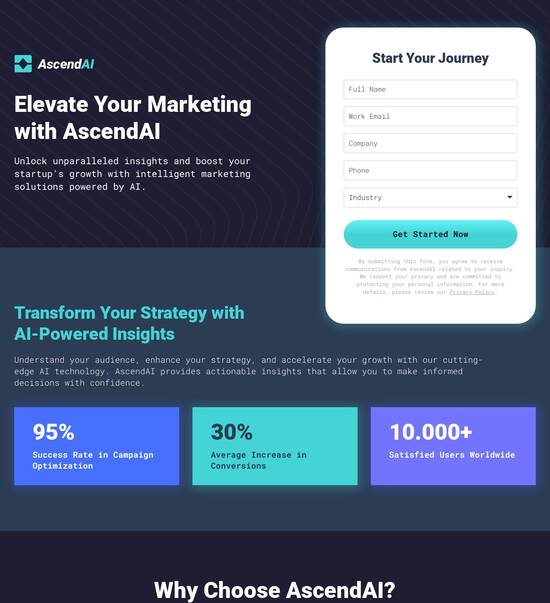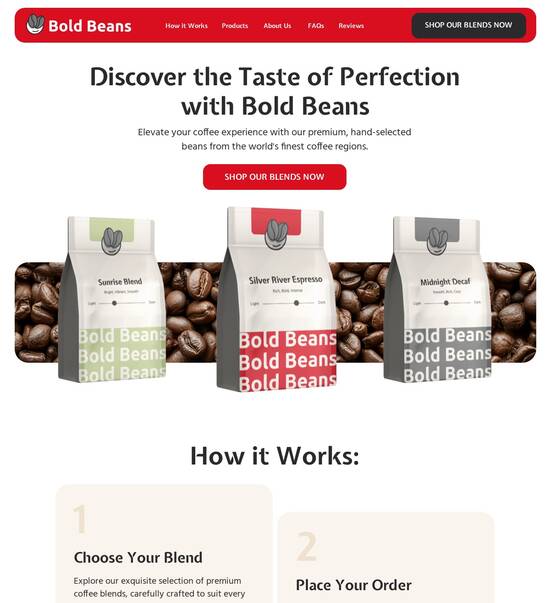
HTML page template with interactive weather widget
Explore Similar TemplatesAbout template
Use HTML page templates with interactive weather widget and make your communications easy and transparent. Try our solution today.
Recommended templates

Easy to build without coding
With the intuitive drag-and-drop builder, anyone on your team can create high-converting pages without any knowledge of code or design. Make enhancements to your landing page with custom widgets using Javascript, HTML/CSS, or third-party scripts.

Multiple layouts for any industry and goal
Select from 500+ landing page layouts built to boost conversions across industry-specific scenarios. Customize them by adjusting fonts, adding images, and generating on-brand content with the AI assistant. Quickly scale with Instablocks® and Global Blocks that you can save, reuse, and update globally.

Loads fast and looks polished on any device
Every template is responsive, which means they present professionally on any device and load blazingly fast with our Thor Render Engine. You can also power them up with Google AMP technology to deliver an unparalleled mobile experience and drive higher conversions.

Robust analytics & experimentation
Get real-time updates and reporting across all your devices, showing the number of visitors, conversions, cost-per-visitor, and cost-per-lead. Launch AI-powered experiments, run A/B tests, and use heatmaps to analyze user behavior, then optimize your landing page to maximize conversions.







Easy to build without coding
With the intuitive drag-and-drop builder, anyone on your team can create high-converting pages without any knowledge of code or design. Make enhancements to your landing page with custom widgets using Javascript, HTML/CSS, or third-party scripts.
Multiple layouts for any industry and goal
Select from 500+ landing page layouts built to boost conversions across industry-specific scenarios. Customize them by adjusting fonts, adding images, and generating on-brand content with the AI assistant. Quickly scale with Instablocks® and Global Blocks that you can save, reuse, and update globally.
Loads fast and looks polished on any device
Every template is responsive, which means they present professionally on any device and load blazingly fast with our Thor Render Engine.
Robust analytics & experimentation
Get real-time updates and reporting across all your devices, showing the number of visitors, conversions, cost-per-visitor, and cost-per-lead. Launch AI-powered experiments, run A/B tests, and use heatmaps to analyze user behavior, then optimize your landing page to maximize conversions.
All the features you need to build weather widget html code
Explore more featuresLearn how to build embed weather widget on website
Frequently asked questions about weather widget for html
Leading the way in building high-performing landing pages





Free weather widget for your website: Your ultimate how-to guide
In the competitive landscape of digital marketing, having a powerful landing page is essential. Instapage stands out as an all-in-one platform that provides marketers across various industries—from Tech/SaaS to Education—with robust tools to enhance their campaigns. This guide will take you through the steps of leveraging Instapage to accelerate your marketing efforts, optimize conversions, and achieve a better ROI.
Understanding the power of landing pages
Landing pages serve as the crucial interface between visitors and your marketing campaigns. They are designed with a single goal: to convert visitors into leads or customers. Instapage simplifies the landing page creation process, allowing you to focus on what matters most—driving results. Here are key aspects that underline their importance:
- Conversion Rate Optimization (CRO): Instapage's built-in tools allow for A/B testing, enabling you to find the most effective landing page designs and messages.
- Simplicity in Design: With over 100 templates, you can quickly craft visually appealing pages without needing coding skills.
- Integration Capabilities: Instapage seamlessly integrates with numerous marketing tools, ensuring smooth data flow and efficient campaign management.
Step 1: Select the right template
Choosing a template that aligns with your campaign goals is the first step towards creating an effective landing page. Instapage offers a diverse selection of high-converting templates that can be customized to fit your brand.
Step 2: Personalize your content
Personalization is key when trying to engage your audience. Use Instapage's dynamic text replacement feature to tailor content for different segments. Here's how to personalize effectively:
- Targeted Messaging: Adjust headlines and calls to action based on the source of the traffic.
- Visual Appeal: Incorporate images and videos that resonate with your specific audience.
- Social Proof: Include testimonials or case studies relevant to the vertical you're addressing.
Step 3: Utilize optimization features
Once your landing page is live, it’s essential to use Instapage's optimization features to ensure it's performing at its best. Monitoring and tweaking are vital components of conversion improvement.
- Conduct A/B Tests: Experiment with different layouts and content to find what resonates most with your audience.
- Leverage Heatmaps: Use heatmaps to track how users interact with your page and adjust accordingly.
- Analytics Dashboard: Regularly check your performance metrics to evaluate traffic sources and conversion rates.
By following these steps, you can maximize the impact of your landing pages and improve your marketing ROI significantly. Instapage helps streamline this process, giving you the tools necessary for success.
Start optimizing your digital marketing campaigns with Instapage today. Leverage our powerful landing page tools to ensure you capture every opportunity for conversion!
People also ask about weather based website banner
HTML page template with interactive weather widget
Harnessing real-time data: The impact of weather on user engagement
Weather influences our daily lives in more ways than one. From deciding what to wear to determining outdoor plans, it holds significant sway over consumer behavior. As businesses look to enhance user engagement on their websites, integrating weather information can provide users with personalized experiences, making the digital interactions relatable and relevant. By incorporating real-time weather data into a webpage, marketers can cater more precisely to the contextual needs and expectations of users.
Understanding the need for weather integration in web design
Ultimately, presenting weather data on websites can enhance user experience by bringing local context into digital interactions. Websites that reflect local weather are often perceived as more engaging and relevant. Additionally, as users increasingly expect personalization in digital platforms, integrating local weather data caters to these expectations, thereby increasing user satisfaction.
Enhances user experience by providing localized content.
Meets growing user expectations for personalization.
Influences consumer behavior, especially in sectors like travel, hospitality, and retail.
The anatomy of a weather widget: Design considerations
Creating an effective weather widget requires careful thought about its components. An engaging and interactive weather widget should display current temperature, offer an hourly forecast, and include essential indicators like humidity, pressure, and wind speed. Each of these components not only informs the user but also enhances the interactive experience.
Aesthetics play a crucial role in design, too. Choosing the right color scheme can help align the widget with the overall branding of the website, while ensuring accessibility allows diverse audiences to engage with the content effectively. Paying attention to these design considerations will lead to a weather widget that is not just functional but also an integral part of the site's overall design.
Weather data sources: Ensuring accuracy and reliability
For a weather widget to be effective, it needs data from reliable sources. Leading weather data providers offer real-time conditions, forecasts, and historical weather data. Displaying accurate information is vital; hence, understanding what types of data can be fetched and how to effectively integrate them into the widget is essential.
Current weather conditions, such as temperature and precipitation.
Forecasting capabilities for upcoming days.
Historical weather data to help users analyze trends.
Best practices for API integration ensure that fetching this data is streamlined, helping maintain the widget’s performance without overwhelming users with complex information.
Crafting the perfect HTML page template
To effectively display a weather widget, it's essential to structure the HTML document correctly. Utilizing essential HTML tags provides a clear setup and enables better readability for search engines. This includes using meta tags to optimize SEO; relevant keywords embedded within these tags help in establishing the webpage's relevance.
Include necessary tags such as , , and .
Meta tags should cover title, description, and keywords.
Make sure to incorporate responsive design to enhance user experience.
Building the interactive weather widget component
Developing the widget requires a harmonious blend of HTML, CSS, and JavaScript. The basic structure includes a designated area in the HTML where the widget will be displayed. This is followed by styling with CSS, ensuring the widget remains visually appealing regardless of the website’s design.
Interactivity is provided through JavaScript functionalities. By implementing features like location detection and data fetching, users can receive real-time updates tailored to their context. Using libraries such as Chart.js can enhance the widget's capabilities, enabling graphical representations of weather data that further engage users.
Location detection: Tailoring weather information
To maximize user engagement, it's essential to tailor weather information to the user’s location. The Geolocation API can automatically detect user locations, making it seamless for them to receive accurate weather updates. Additionally, providing a search option or dropdown lists for manual selection adds flexibility, ensuring all users can access the information they need.
Automatically detects user location for convenience.
Search functionality allows users to find specific locations.
Dropdown lists simplify location selections.
Dynamic weather parameters: Providing comprehensive insights
A robust weather widget should provide comprehensive insights into various weather parameters. Displaying metrics such as temperature in different scales (Celsius and Fahrenheit) caters to global users. Additionally, showcasing humidity levels and their significance can help users understand how weather impacts comfort and health.
Including atmospheric pressure is essential as it can inform users about potential weather shifts, while understanding wind speed projections can impact decision-making, especially for those involved in outdoor or travel activities. Providing options for users to customize which data they view enhances the interactivity and relevance of the weather widget.
Leveraging weather integration for business solutions
Integrating a weather widget offers strategic benefits to businesses. Many e-commerce sites have seen improved conversion rates by incorporating weather data, as it allows users to make informed purchasing decisions based on local conditions. Local businesses can leverage tailored forecasts, helping them promote relevant services during specific weather conditions.
E-commerce sites that saw higher conversions with accurate weather forecasts.
Local businesses enhancing engagement with timely weather updates.
Travel and hospitality websites enriching user experiences with dynamic content tailored to the weather.
These examples underscore how weather integration can not only elevate user engagement but also drive business objectives, making it a vital component of modern web design.
Strategic benefits of an interactive weather widget
The advantages of an interactive weather widget extend beyond just delivering weather data. Enhancing the relevance of website content allows businesses to connect deeper with their audience. When users see content that resonates with their real-world experiences, trust is built through transparency.
Encouraging user interaction is another crucial benefit. Users are more likely to engage with a website that offers interactive features, and longer dwell times can typically lead to improved conversion rates. As such, integrating an interactive weather widget can indeed be considered a wise investment for elevating customer engagement.
Emerging trends and future directions
As technology evolves, so too does the potential for integrating artificial intelligence with weather data. Advances in predictive analytics are beginning to offer forecasts that are not only more accurate but also personalized based on user preferences and historical data. These improvements can significantly enhance user interaction.
AI-driven improvements in weather accuracy.
Personalized user experiences informed by weather trends.
Mobile responsiveness: Ensuring a seamless view on all devices
Ensuring that the weather widget remains effective across all devices requires attention to responsive design. Developers need to consider how the layout, size, and functionality of the widget will appear on various screen sizes. This adaptability is key to providing a smooth user experience.
Conducting extensive testing across multiple devices is recommended to ensure that users receive consistent experiences, regardless of whether they access the website from desktops, tablets, or smartphones. Such proactive measures ensure the weather widget remains a valuable asset to any business's web design.
Gamifying weather: Innovative engagement techniques
Engaging users can also be achieved through innovative techniques like gamifying weather interactions. For instance, introducing interactive features such as weather trivia or custom alerts can encourage users to explore the widget further. By creating a community around weather forecasting, websites can enhance user engagement and foster loyalty.
Interactive trivia games related to weather.
Custom alerts for significant weather changes.
Promoting user-generated content related to local weather.
Conclusion: The future of interactive web elements
In summary, integrating an interactive weather widget into your web design not only elevates user experience but also aligns with evolving user expectations. As businesses continue to focus on personalization and engagement, leveraging weather data stands out as a powerful tool to enhance landing page effectiveness and drive conversions.
The future holds exciting potential for further developing weather integration within web templates. By staying ahead of trends such as AI-enhanced forecasting and innovative engagement techniques, businesses can ensure they are well-positioned to capture the interest of their audience and nurture meaningful interactions.
Ready to skyrocket conversions?
Supercharge your ad campaigns with high-performing landing pages
Get started














